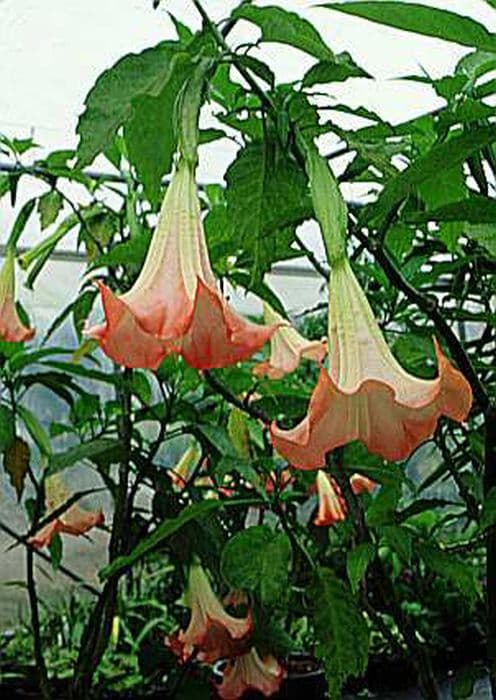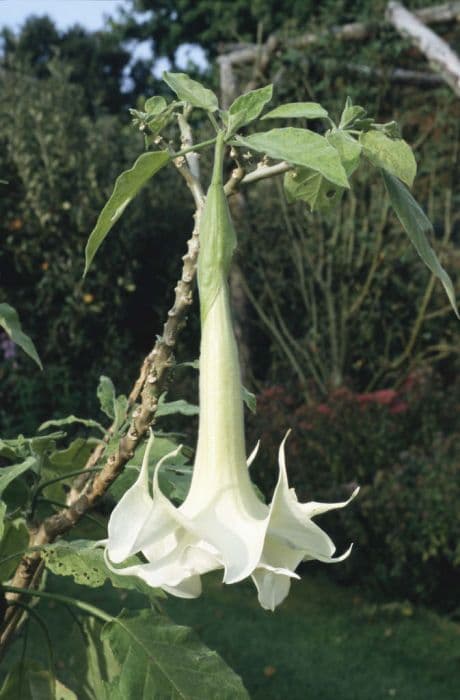Million Bells Calibrachoa Calibasket Radiant Orange = 'Wescaraor' (Calibasket Series)
![calibrachoa [Calibasket Radiant Orange]](/_next/image?url=https%3A%2F%2Fplants-admin.emdemapps.com%2Fimages%2Fplants%2F%2Fimages%2F604b536d43cb2.png&w=3840&q=75)
ABOUT
Calibrachoa Calibasket Radiant Orange is a vibrant ornamental plant with a lush appearance, characterized by its plentiful trumpet-shaped flowers that boast a lively, radiant orange color. The blossoms typically feature a yellow throat, which adds a delightful contrast, enhancing their overall visual appeal. The foliage is generally dense, with small, green leaves that provide a complementary backdrop to the profusion of orange blooms. The plant has a trailing habit, with stems that cascade and intertwine, creating a full and rich presentation. This makes it especially suitable for hanging baskets or containers where the trailing stems can drape gracefully over the edges. The overall impression is that of a cheerful, brightly-colored plant that can add a pop of color and visual interest to any garden setting or outdoor space.
About this plant
 Names
NamesSynonyms
Million Bells, Mini Petunia
Common names
Calibrachoa Calibasket Radiant Orange = 'Wescaraor' (Calibasket Series)
 Toxicity
ToxicityTo humans
Calibrachoa, commonly known as million bells, is generally not considered toxic to humans. There is no well-documented evidence of toxicity causing severe health issues upon ingestion. However, like with any plant, individual allergies or sensitivities can occur, and it is always advisable to avoid ingesting parts of ornamental plants as a precaution. If any part of the million bells plant is ingested and symptoms appear, it is recommended to consult a medical professional.
To pets
Calibrachoa, known as million bells, is not typically listed as a toxic plant to pets such as dogs and cats. Although it is not specifically known to be poisonous, individual animals may have sensitivities or allergic reactions to the plant. As with humans, it is generally advised to prevent pets from ingesting plants not meant for consumption. If your pet does ingest million bells and exhibits any unusual symptoms, it is best to contact a veterinarian.
 Characteristics
CharacteristicsLife cycle
Annuals
Foliage type
Evergreen
Color of leaves
Green
Flower color
Orange
Height
1 foot [30 cm]
Spread
2 feet [60 cm]
Plant type
Herb
Hardiness zones
9
Native area
South America
Benefits
 General Benefits
General Benefits- Vibrant Color: Adds a burst of radiant orange to hanging baskets, containers, or garden beds.
- Continuous Blooming: Produces flowers throughout the growing season, from spring to fall.
- Low Maintenance: Requires minimal care once established, making it ideal for busy gardeners.
- Compact Growth: Its mounding and trailing habit is perfect for small spaces and hanging baskets.
- Drought Tolerance: Can withstand periods of low water once established, minimizing the need for constant watering.
- Heat Resistance: Thrives in warm climates and can tolerate high temperatures during summer.
- Pest Resistance: Resistant to many common pests, reducing the need for chemical treatments.
- Attracts Pollinators: Flowers attract hummingbirds and butterflies, promoting biodiversity.
 Medical Properties
Medical PropertiesThis plant is not used for medical purposes.
 Air-purifying Qualities
Air-purifying QualitiesThis plant is not specifically known for air purifying qualities.
 Other Uses
Other Uses- Photography Enhancement: Calibrachoa can be used as a vibrant, natural backdrop or subject in photography to enhance color contrast and aesthetic appeal.
- Edible Garnish: While not commonly known for edibility, the petals of Calibrachoa can be used as a decorative, colorful garnish on desserts and salads after ensuring they're free of pesticides and safe for consumption.
- Artistic Inspiration: The bright hues of Calibrachoa can inspire artists for paintings, fabric designs, and other forms of visual art requiring vivid color palettes.
- Education and Research: These plants are utilized in educational settings for studying plant growth, hybridization, and the effects of environmental factors on flowering plants.
- Themed Events: Calibrachoa can be incorporated into event decor for themed parties, such as tropical or summer celebrations, due to their bright orange color.
- Crafting: Dried Calibrachoa flowers can be used in various crafts such as making bookmarks, greeting cards, or pressed flower arrangements.
- Natural Dye: The pigments from Calibrachoa petals might be used to create natural dyes for textiles, though this is less common and requires experimentation.
- Container Gardening Education: Calibrachoa serves as an excellent example when teaching about the principles and practices of container gardening due to its adaptability and use in hanging baskets.
- Seasonal Decorations: The flowers can be used for creating live decorations such as living wreaths or table centerpieces in the appropriate seasons.
- Plant Combinations: Gardeners can use Calibrachoa in mixed plantings to achieve a balance of color and texture, helping teach principles of landscape design.
Interesting Facts
 Feng Shui
Feng ShuiMini Petunia is not used in Feng Shui practice.
 Zodiac Sign Compitability
Zodiac Sign CompitabilityMini Petunia is not used in astrology practice.
 Plant Symbolism
Plant Symbolism- Joy: The bright, radiant orange coloring of the Million Bells represents joy and happiness in a garden space, reflecting the vibrant energy it brings to its surroundings.
- Warmth: Orange is a color that symbolizes warmth and comfort, similar to a sunny day, which makes the Million Bells a representation of a warm and welcoming environment.
- Celebration: With its ample blooms and continuous flowering, the Million Bells is often associated with a celebratory mood, making it perfect for festive occasions.
- Enthusiasm: The plant's vigorous growth and enthusiastic spread embody a spirit of enthusiasm and zest for life.
 Water
WaterMillion Bells, like the Calibrachoa 'Wescaraor', should be watered thoroughly when the top inch of soil feels dry to the touch. This generally means watering every few days during hot weather, but be sure to check the soil moisture level regularly. During the growing season, a basket might need about 1 to 2 gallons per week, depending on the climate and the size of the basket. It's crucial not to let the plant sit in waterlogged soil as this can cause root rot. Instead, provide enough water to soak the root zone and allow excess water to drain away.
 Light
LightMillion Bells thrive in full sun conditions, which means placing the Calibrachoa 'Wescaraor' in a spot where it receives at least 6 to 8 hours of direct sunlight each day. These plants can tolerate some light shade, particularly in the afternoon, but too much shade can result in fewer blooms and leggy growth.
 Temperature
TemperatureMillion Bells are warm-weather plants and Calibrachoa 'Wescaraor' grows best in temperatures between 55 and 85 degrees Fahrenheit. They can generally tolerate temperatures down to about 40 degrees Fahrenheit but should be protected from frost. The ideal temperature range ensures vigorous growth and abundant flowering.
 Pruning
PruningMillion Bells, including Calibrachoa 'Wescaraor', benefit from regular pruning to encourage bushier growth and more blooms. Pinch back the tips of stems every few weeks to promote branching. The best time for pruning is after a flush of flowers begins to fade, which may occur several times throughout the growing season.
 Cleaning
CleaningAs needed
 Soil
SoilFor Calibrachoa, also known as Million Bells, a well-draining potting mix is essential; consider a blend of peat, perlite, and vermiculite. A slightly acidic to neutral pH between 5.5 and 6.5 is ideal for the best growth.
 Repotting
RepottingMillion Bells should be repotted annually to replenish nutrients and prevent root-bound conditions. Repotting is most beneficial in the spring before the onset of the growing season.
 Humidity & Misting
Humidity & MistingMillion Bells thrive in moderate humidity levels but are tolerant of a range of conditions; strive to maintain humidity around 40-70% for optimal health.
 Suitable locations
Suitable locationsIndoor
Place in well-lit area avoiding direct afternoon sun.
Outdoor
Full sun to part shade, protect from harsh elements.
Hardiness zone
9-11 USDA
 Life cycle
Life cycleThe life of Calibrachoa Calibasket Radiant Orange begins with the germination of seeds, which requires warm temperatures and consistent moisture. After germination, seedlings emerge and grow into young plants, forming a small rosette of leaves at the soil surface. As they mature, the plants develop a robust root system and numerous branching stems, which will eventually bear the vibrant orange flowers characteristic of the Calibasket series. The flowering stage can last several months, especially if the plant is deadheaded regularly and provided with ample sunlight and nutrients. Following pollination, the plant produces small, dry fruits containing seeds, completing its reproductive cycle. If environmental conditions are unfavorable or at the end of the growing season, the plant will enter a dormancy or die, depending on whether it is treated as an annual or perennial in the specific climate.
 Propogation
PropogationPropogation time
Spring-Summer
The most popular method for propagating Calibrachoa, specifically the Calibasket Radiant Orange ‘Wescaraor’, is through cuttings. This is often done in late winter or early spring before the growing season begins. To propagate by cuttings, select a healthy stem with no flower buds and cut a 3 to 4-inch (7.6 to 10.2 cm) section just below a node. Strip the leaves from the lower half of the cutting and dip the cut end into rooting hormone. Then, insert the cutting into a moistened soilless potting mix, ensuring that at least one node is below the surface. The cutting should be kept in a warm, well-lit area, but out of direct sunlight, and the soil should remain consistently moist but not soggy. Roots typically develop within a few weeks after which the new plant can be transplanted to a larger pot or directly into the garden.


![Calibrachoa [Aloha Classic Blue Sky]](/_next/image?url=https%3A%2F%2Fplants-admin.emdemapps.com%2Fimages%2Fplants%2F%2Fimages%2F604b636c3778b.png&w=640&q=75)
![Calibrachoa [Aloha Classic Gold]](/_next/image?url=https%3A%2F%2Fplants-admin.emdemapps.com%2Fimages%2Fplants%2F%2Fimages%2F604b6284c573e.png&w=640&q=75)
![Calibrachoa [Aloha Classic Tiki Soft Pink]](/_next/image?url=https%3A%2F%2Fplants-admin.emdemapps.com%2Fimages%2Fplants%2F%2Fimages%2F604b548e0a5ef.png&w=640&q=75)
![Calibrachoa [Cabaret Deep Yellow]](/_next/image?url=https%3A%2F%2Fplants-admin.emdemapps.com%2Fimages%2Fplants%2F%2Fimages%2F604b5f20ca3ef.png&w=640&q=75)
![Calibrachoa [Caloha Classic Blue Velvet]](/_next/image?url=https%3A%2F%2Fplants-admin.emdemapps.com%2Fimages%2Fplants%2F%2Fimages%2F604b604884a75.png&w=640&q=75)
![Calibrachoa [Caloha Classic Honey White]](/_next/image?url=https%3A%2F%2Fplants-admin.emdemapps.com%2Fimages%2Fplants%2F%2Fimages%2F604b5f56e0beb.png&w=640&q=75)
![Calibrachoa [Caloha Classic Yellow Chocolate Ring]](/_next/image?url=https%3A%2F%2Fplants-admin.emdemapps.com%2Fimages%2Fplants%2F%2Fimages%2F604b538aede95.png&w=640&q=75)
![Calibrachoa [Caloha Grand Purple]](/_next/image?url=https%3A%2F%2Fplants-admin.emdemapps.com%2Fimages%2Fplants%2F%2Fimages%2F604b6192993d2.png&w=640&q=75)